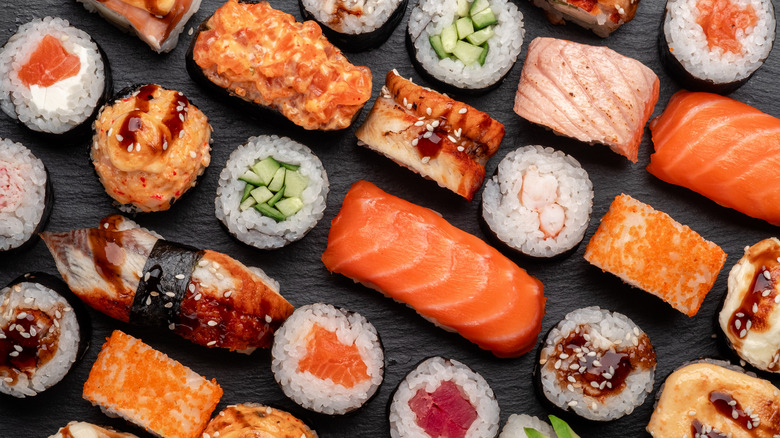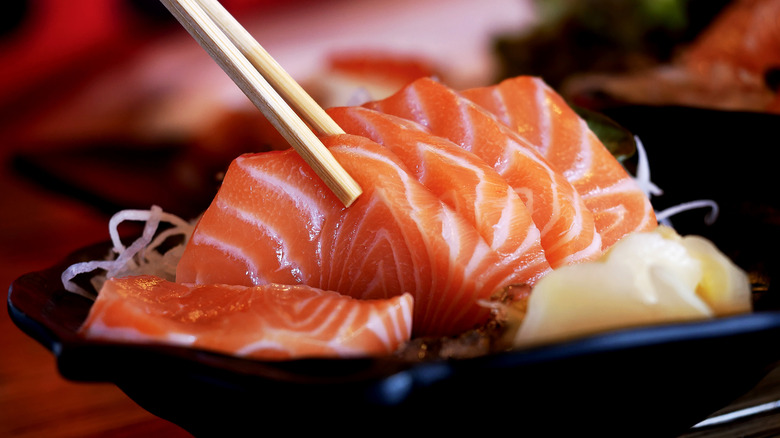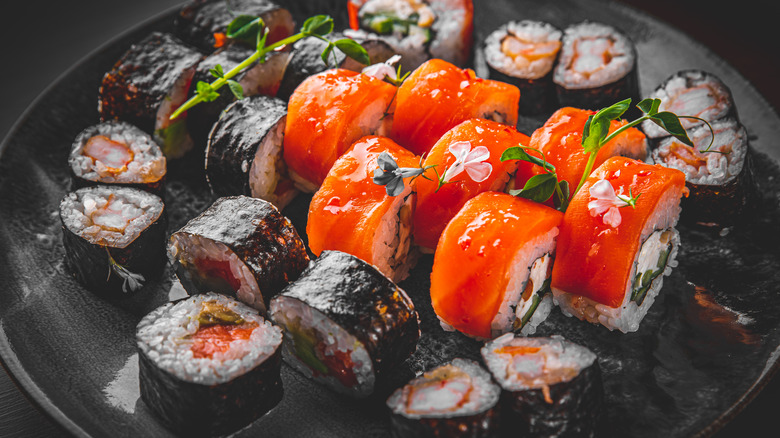What's The Difference Between Sushi And Sashimi?
Sushi is one of those polarizing foods that people either love or hate. Not liking raw fish is a commonly cited reason for disliking sushi, but is that really a fair assessment? Sushi is a staple in Japanese cuisine and has become increasingly popular in the Western world, but the term is broader than you'd think. First, let's clear something up: "sushi" doesn't mean there's going to be raw fish involved, says Travel Japan. While many sushi rolls do feature raw fish, it's not part of the definition of sushi and you can certainly order rolls without it — but if you order sashimi, raw fish is just about all you'll get.
At any given Japanese restaurant, you may even order sushi and sashimi at the same time, but they technically fall under different categories. There are several types of sushi, but only one type of sashimi (though it can be made with many different types of fish). Sushi is made with rice and can contain raw or cooked fish as well as vegetables and sometimes sauces or drizzles, which makes it potentially suitable for vegetarians or even vegans, depending on the roll. Sashimi, on the other hand ... not so much. Either way, you'll typically find both on the menu at your favorite sushi restaurant — so what's the difference between these sometimes confusing sushi terms?
Sushi versus sashimi
According to the official Japan travel site, the term sushi actually comes from a combination of the Japanese words "su" and "meshi," which translate to vinegar and rice in English. That's because sushi rice is made sticky with the addition of vinegar so that it can easily be formed into little balls for nigiri or bind to the seaweed wrap in a maki-style roll. Under the umbrella of sushi, there are actually several types – six, to be exact. And while vinegared rice is a given, raw fish is not part of the official definition.
Sashimi, on the other hand, translates to "pierced body," according to Benihana. While sashimi is frequently confused with nigiri, which consists of a ball of sticky rice with a piece of thinly sliced raw fish laid across the top, it actually doesn't contain rice at all. Instead, sashimi consists entirely of thinly-sliced raw meat — typically fish in the United States, although other forms of meat like beef or deer are used in Japan.
Japan Guide advises that sashimi is usually eaten by giving the meat a quick dunk in a dish of soy sauce and maybe a small dollop of wasabi if you like a little more bite — a far cry from the colorful and decadent toppings on your go-to sushi order. However, it's important to note that the raw fish that makes up sashimi are often some of the same kinds of raw fish used in sushi rolls, just sliced differently and eaten on their own rather than atop a roll or inside it.
Ordering sushi and sashimi
Maki or makizushi is likely the most familiar style of sushi to Americans and is associated with things like the classic California roll or any of those colorful, multi-ingredient rolls that you see at your favorite restaurant. But you know those really big rolls that are at times difficult to fit in your mouth in one bite? That's more of an American thing than traditional Japanese. The Michelin Guide details how in Japan, simplicity in sushi is preferred and people traditionally opt for no-frills selections like nigiri or sashimi. If you want a more authentic experience or to truly taste the meat's nuances, maybe try ordering a simpler roll next time you go out.
Speaking of letting the fish itself shine, when you see sashimi on the menu, it may be in a separate category from the sushi rolls, and often listed by the type of fish being served. Commonly used fish for sashimi, according to Japan Guide, include tuna, salmon, and amberjack, but you can also get other types like shrimp, uni, or even salmon roe.
Most sushi restaurants will offer a variety of maki rolls, nigiri, and sashimi for you to choose from. Even though sashimi doesn't qualify as sushi because it doesn't contain any rice, you'll still hear it colloquially referred to as sushi — and you can enjoy both equally now that you know what you're ordering.


